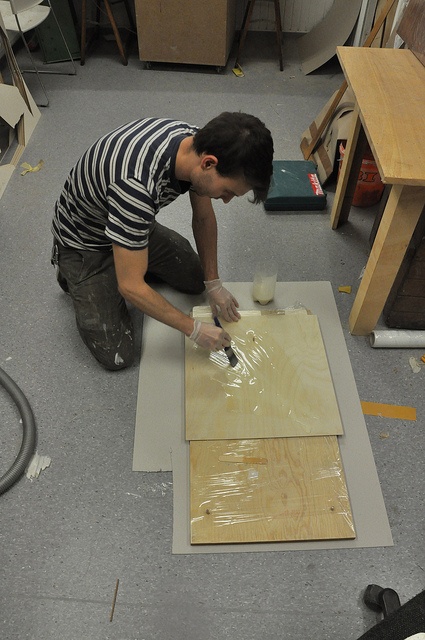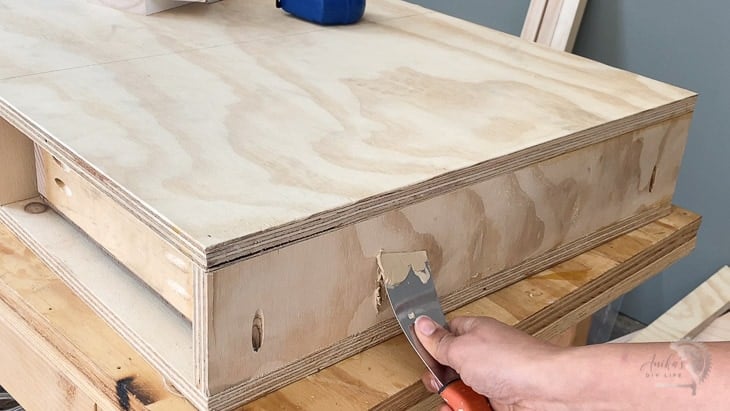So, you’ve got a plywood project on your hands and you’re wondering, “Do I need to prime plywood before painting?” Well, my friend, you’ve come to the right place.
Painting plywood can be a bit tricky, but don’t fret! In this article, we’ll dive into the nitty-gritty details of whether priming your plywood is necessary before slapping on that beautiful coat of paint.
But first, let’s quickly address what priming actually means. In simple terms, priming is like giving your plywood a nice little makeover before the paint party starts. It helps create a smooth and even surface, enhances the durability of the paint, and prevents any unsightly stains from bleeding through.
So, grab your paintbrush and let’s uncover the truth about priming plywood before painting!

Do I Need to Prime Plywood Before Painting? A Guide to Achieving a Perfect Finish
Plywood is a versatile material used in various applications, from construction to furniture making. If you’re planning to paint plywood, one question that often arises is whether priming is necessary. In this article, we’ll explore the importance of priming plywood before painting, the benefits it offers, and some valuable tips to ensure a flawless finish.
Understanding the Purpose of Primer
Primer serves as a preparatory layer between the surface being painted and the paint itself. Its main purpose is to enhance adhesion, seal the surface, and promote a uniform finish. When it comes to plywood, priming is especially important due to the unique characteristics of this material. Plywood is made up of layers of wood veneer glued together, and each layer can absorb paint differently, resulting in an uneven finish if not properly primed.
Priming plywood provides several key benefits. Firstly, it helps to seal the porous surface of the wood, preventing the paint from being absorbed too quickly and resulting in patchy or uneven coverage. Additionally, primer creates a smooth and uniform surface for the paint to adhere to, ensuring better color vibrancy and longevity. Lastly, primer also helps to hide any imperfections or discolorations in the wood, resulting in a more professional-looking finish.
The Steps to Priming Plywood for Painting
To achieve the best results when painting plywood, it is recommended to follow a few key steps. The first step is to ensure that the plywood surface is clean and free from any dust, dirt, or debris. Use a damp cloth or a vacuum with a brush attachment to remove any loose particles. Next, inspect the surface for any imperfections, such as knots or rough areas, and sand them down to create a smoother surface.
Before applying the primer, it is crucial to choose the right type of primer for plywood. Opt for a high-quality primer specifically designed for wood surfaces. Apply the primer using a brush or roller, making sure to cover the entire surface evenly. Allow the primer to dry completely according to the manufacturer’s instructions before proceeding with the painting process.
Tips for Priming and Painting Plywood
1. Choose the right type of primer: Look for a primer that is specifically formulated for wood surfaces, as this will provide the best adhesion and coverage.
2. Sand the plywood: Before priming, sand the plywood surface to create a smooth and even texture. This will ensure better adhesion and a more professional finish.
3. Use an appropriate brush or roller: Select a brush or roller that is suitable for the type of paint and primer you are using. This will help to achieve a smooth and even application.
4. Apply multiple coats if necessary: Depending on the condition and color of the plywood, it may be necessary to apply multiple coats of primer and paint to achieve a desired finish. Follow the manufacturer’s instructions for the recommended number of coats.
5. Allow ample drying time: Be patient and allow each layer of primer and paint to dry fully before proceeding with the next coat or any additional steps. This will ensure a durable and long-lasting finish.
The Benefits of Priming Plywood Before Painting
Priming plywood before painting offers various benefits that contribute to a professional-looking and long-lasting finish.
Enhanced Adhesion
Primer improves the adhesion of the paint to the plywood surface, preventing it from peeling or chipping over time. With proper priming, the paint forms a strong bond with the wood, resulting in a durable and long-lasting finish.
Improved Coverage
By sealing the porous surface of the plywood, primer prevents the paint from being absorbed too quickly and unevenly. This ensures that the paint covers the surface evenly, providing a consistent and uniform finish with vibrant colors.
Protection and Durability
Priming plywood creates a protective barrier between the wood and the paint, shielding it from moisture, UV rays, and other environmental factors. This helps to prevent warping, rotting, and other damage, resulting in a longer lifespan for the painted plywood.
The Difference Priming Makes: Examples and Comparisons
To showcase the impact of priming plywood before painting, let’s compare two scenarios – one with proper priming and the other without.
Scenario 1: Painting Plywood Without Priming
Without priming, the paint can be quickly absorbed into the porous surface of the plywood, resulting in uneven coverage and a dull finish. Knots and imperfections in the wood may also be more visible, affecting the overall appearance. Over time, the paint may start to peel or chip, requiring frequent touch-ups or recoating.
Scenario 2: Painting Plywood with Proper Priming
With proper priming, the paint adheres more effectively to the plywood surface. The primer helps to even out the absorption of the paint, resulting in a smooth and uniform finish. Knots and imperfections are hidden, creating a more polished look. The paint is also more resistant to peeling, chipping, and other damage, ensuring a longer lifespan for the painted plywood.
In conclusion, priming plywood before painting is essential to achieve a flawless and professional finish. It enhances adhesion, improves coverage, and provides protection and durability. By following proper priming and painting techniques, you can ensure that your painted plywood projects stand the test of time and maintain their vibrant appearance. So, next time you’re planning to paint plywood, don’t skip the priming step – it will make all the difference!
Key Takeaways
- Priming plywood before painting is highly recommended.
- Priming helps the paint adhere better to the surface.
- It also seals the wood and prevents moisture damage.
- Priming creates a smooth and even base for the paint.
- Choose a primer suitable for plywood to achieve the best results.
Frequently Asked Questions
Are you wondering if you need to prime plywood before painting? Here are some commonly asked questions to help guide you with your painting project.
1. How do I prepare plywood for painting?
Before painting plywood, it’s important to properly prepare the surface for optimal adhesion and a smooth finish. Start by cleaning the plywood to remove any dust, dirt, or grease. Then, fill any holes or imperfections with wood putty and sand the entire surface to create a smooth texture. If the plywood has been previously painted, it’s essential to remove any loose or flaking paint. Once the surface is clean and smooth, you can proceed with priming and painting.
By following these preparation steps, you will ensure that the paint adheres better to the plywood, resulting in a longer-lasting and more professional-looking finish.
2. What is the purpose of priming plywood before painting?
Priming plywood before painting serves several important purposes. Firstly, it helps to seal the porous nature of the wood, preventing the paint from being absorbed unevenly and ensuring a more even color and finish. Additionally, primer creates a strong bond between the plywood and the paint, increasing its durability and resistance to chipping or peeling.
Priming also helps to prevent stains or discoloration from bleeding through the paint. This is particularly important when painting plywood with knots or other wood imperfections. Overall, priming plywood before painting is a crucial step that enhances the appearance and longevity of your paint job.
3. Can I skip priming if the plywood is already pre-primed?
If your plywood is already pre-primed, you may be able to skip the initial priming step. Pre-primed plywood often has a surface that is ready for paint, as it has been sealed and prepared by the manufacturer. However, it’s still essential to assess the quality of the pre-primed surface.
Check for any imperfections, rough spots, or areas where the pre-priming may have worn off. If you notice any of these issues, it’s recommended to spot prime those areas before proceeding with painting. By doing this, you will ensure that you have a smooth and consistent surface for your final coat of paint.
4. Can I apply paint directly to untreated plywood?
While it’s technically possible to apply paint directly to untreated plywood, it’s generally not recommended. Untreated plywood is porous and can absorb paint unevenly, resulting in a blotchy and less-than-desirable finish. Additionally, the paint may not adhere as well or provide optimal durability without a primer.
To achieve the best results, it’s advisable to prime untreated plywood before painting. The primer will create a sealed and smooth surface for the paint, ensuring better adhesion and a more professional-looking finish.
5. What type of primer should I use for painting plywood?
Choosing the right primer for plywood is essential for a successful paint job. For most plywood projects, an oil-based or latex-based primer will work well. Oil-based primers are known for their excellent adhesion and ability to seal the wood, while latex-based primers are less toxic and dry faster.
If you plan to paint the plywood with latex paint, using a latex-based primer is recommended. However, if you are going to apply oil-based paint, an oil-based primer is usually the better choice. Always follow the manufacturer’s guidelines for the specific primer and paint you are using to ensure compatibility and the best results.

Buy The RIGHT Primer
Summary
Priming plywood before painting is important because it helps the paint adhere better and last longer. Primer creates a smooth surface, seals the wood, and prevents moisture damage. It also reduces the number of paint coats needed and helps achieve a more even color.
If you skip priming, the paint might not stick properly, leading to chipping and peeling. Water can seep into the wood, causing warping and rotting. So, take the time to prime your plywood before painting to ensure a beautiful and long-lasting finish.
